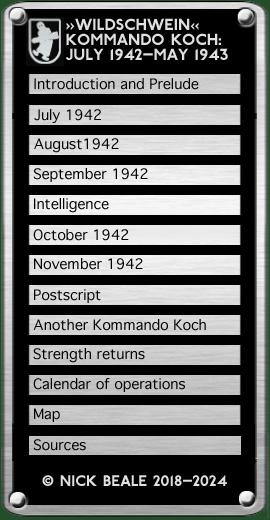|
One of the Heinkels mentioned above was in action from 1842–2200 hours. British Intelligence noted, presumably from analysing their signals, that the German ground stations and aircraft “all operated on the same principle”. The Kdo. Koch aircraft taking part in the night’s operations landed as follows: a »WIM« Heinkel at 0035; a second »WIM« He 111 was expected at Shterasat, Egypt (about 7 km along the main road leading east from Sidi Barrani); a Lichtenstein Ju 88 which had patrolled west of Greece was back on the ground at 0115. No. 46 Squadron’s defending night fighter crews, operating from Idku and Landing Ground 224 (Cairo West) were hamstrung: A contact was obtained but interference made it difficult to follow. A great deal of interference encountered. Five attempts were made at following interference but nothing came of them. Three contacts were obtained but were swamped in interference and could not be worked. Two contacts were obtained but lost in interference. Owing to interference no contacts were obtained but an A/C was seen to cross the course of ours. Our A/C turned but neither contact or visual was obtained. A contact was obtained but unworkable owing to interference.
Although German efforts that night were directed against radars in Egypt, a subsequent Operational Research report recalled that: “ASV aircraft first observed serious jamming on the night of the 28th August. After that date almost every ASV aircraft operating in the convoy area experienced jamming in various degrees of intensity.” Operational Research were probably talking about the experiences of P/O Fraser’s crew of No. 221 Squadron (Wellington Mk. VIII, HX473) who had taken off from Landing Ground 226 (Gianaclis, Egypt) at 18.35 on 28 August: "Although severe S.I. jamming was experienced, an enemy convoy was located and a striking force of torpedo Wellingtons homed in. The target was illuminated for the striking force". At 1100 next morning, Oberst Heinrich Aschenbrenner (Chief Signals Officer with Luftflotte 2) signalled Fl.Kps. X’s »WIM-Zentrale«: I require you at once to make arrangements for WIM results to be sent through immediately, direct to the WIM centre. Further, I refuse to prohibit the direct and immediate exchange of experience between WIM Centre and El Daba which was ordered by me. The night of the 29/30th saw a return to convoy protection work (including for the Anna Maria Gualdi) by an He 111 Suchflugzeug (i.e. with search radar) and two »WIM« with jamming transmitters. One of these jammers was up at 1710 and between them they covered five frequencies until 0130 hrs., establishing “several enemy units” (signal sources?) before landing at Kastelli. Some 42 Ju 88 and a dozen He 111 attacking airfields south of Alexandria on the night of 30/31 August were backed up by two Heinkel jammers operating offshore between El Alamein and the target area; they had landed by 0525. An airman who had flown one such mission told his captors that the jamming crews were briefed alongside the rest of the raiding force but the Wildschwein aircraft took off to be in position about a quarter-hour before the bombers arrived, patrolling a beat around 50 km from the coast. No. 46 Squadron’s W/O G.W.C. Thomas and Sgt. A.W. Farquaharson took off at 00.45 GMT on the 31st: Scrambled from Idku. A contact was followed by the Observer obtaining a visual of a single engined A/C 500ft [150 m] above and slightly ahead. This A/C suddenly climbed steeply and came down behind our A/C opening fire with tracer but no hits were experienced. Our pilot took immediate evasive action by climbing to port and the other A/C overshot and was not seen again. Following this a number of contacts were made but all were unworkable owing to interference. This crew went on to obtain thee visual contacts, one of which dropped flare, dazzling Thomas. On the afternoon of the 31st, one He 111 jammer was up at 1705 and was on station protecting a Tobruk-bound convoy from 1820–0100 before landing at 0225. A second operated from 2155 until dawn, patrolling off the coast of Egypt to disrupt the night fighter control channels in support of a raid on Bir Abu Ogos airfield but ground stations were unable to contact it during its mission, although communication was established with the stations at Derna, El Daba, Bardia and Crete-East. The first machine however was updated in the air by listening posts and was ordered to jam four British sets from 2050–0110 then (from 0115–0230) switched its attentions between no fewer than 12 hostile transmitters. The cover name Nachtfalter cropped up again when El Daba advised Kounavi that it had been in action from 0015–0330::
Just before beginning transmission, WIM 9 also advised WIM 7 (via Fliegerkorps X) that there was a night fighter radar on 191 MHz, at a bearing of 85º. A detailed report of the frequencies countered shows that a given hostile radar might typically be jammed for between 10 minutes and an hour. In the early hours of 1 September two crews from No. 46 Squadron reported, respectively “excessive interference” and “Interference on A.I. … after take-off and also Nth-Nth West of Base but not during chase which was very close to Cairo”. A listening station »WAM-Z« reported having detected four ASV frequencies which succeeded one another at short intervals, and ordering aircraft to jam them. As the jamming commenced, the ASV sets were switched off but one came on again from 0205–0223, on 174 mHz. No ground radar transmissions had been picked up apart from two German sets, nor could “our own” jamming output be heard or communication be established with the second of the Wildschwein aircraft
continued on next page …
|
||||||||||||||

